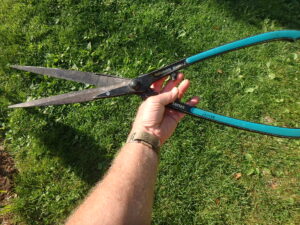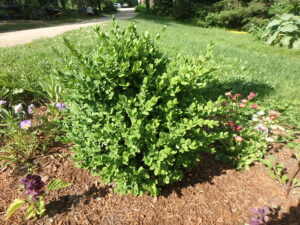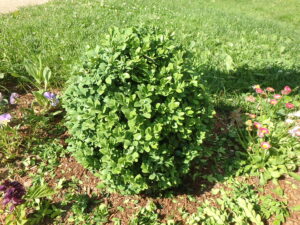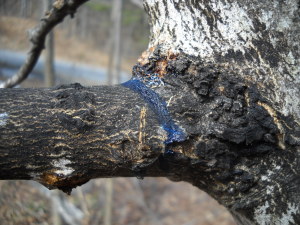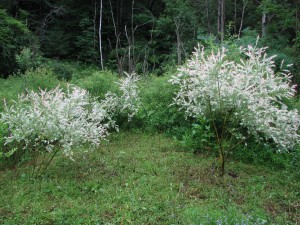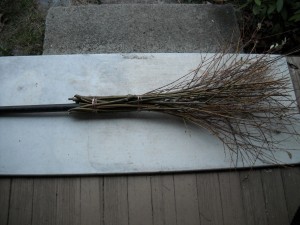It’s Time to Prune Trees and Shrubs
Make your cuts just into the green growth. By doing so you are leaving a growing point for new growth next spring. Most rhododendrons blossom on old wood, which is to say growth that occurred the year before.
British gardeners – and hence, many American gardeners – love boxwoods. They love hedges and portly round balls. Some even create rabbits and other silly sculpture called topiary. If you have boxwoods, they need a light haircut every year in June or July. Never prune them after August, because pruning stimulates new growth and it will be tender, and turn brown and ugly in winter.
When pruning boxwoods, just take a little off with each snip. You can work quickly, but just take a little at a time so you can get the exact shape you want and don’t create holes with a big cut.
Pruning Trees and Shrubs
By now you may have your garden put to bed, raked the leaves and planted spring bulbs. I haven’t, but don’t gloat if you have – there is still work to do. This is the time to prune hardwood trees and shrubs (though not evergreens, which should have been pruned back in July). Take a walk around your property and look for scruffy shrubs or trees with deadwood or crossing branches. Trees are healthier and better looking if pruned regularly, meaning at least once a year.
To me, pruning is a joy. I can’t draw a picture, but I can sculpt a tree, making a messy, un-made bed of a tree into something beautiful. If you haven’t dared to prune, give it a try. Even if you make an “oops!” cut, the tree will recover. Start slowly, never taking off more than 25% of the foliage of a tree or shrub in any given year.
Let’s start with how to prune a shrub. Walk around it 3 times, observing its growth. Is it too tall? Too wide? Is the interior of the shrub cluttered with dozens of small branches? Are there dead branches?
It is easiest to prune once the leaves have fallen so one can see the structure of the plant. My late sister, Ruth Anne, loved to start by sitting down or sprawling out underneath a shrub and looking up through it to see where clutter should be removed. Sometimes I do that too, depending on the species.
Begin by removing any dead branches. You can do that any time of the year. If the leaves have dropped and you are not certain if the branch is dead, rub it with your fingernail. If you see green when you scratch the surface, it is alive. Soon you will also notice that the bark on dead branches is a different color, and the bark is often flakey.
Next, look for branches that are rubbing against others, or branches that shoot through the middle of the shrub. Branches should go up or out, not toward the middle. Remove any that do not follow this rule.
It is important to cut branches so that you do not leave any stubs. Cut back a branch to where it originates, either on a bigger branch or to the trunk. Look for the branch “collar”. This is at the point of origin of a branch and is usually swollen and often wrinkled. Leave the branch collar as that is where the tree will heal itself. If you leave a stub past the branch collar, the stub will have to rot off – a long process – before it can heal. That could allow insects or diseases to damage the tree.
Unlike most trees, many shrubs send up multiple stems from the ground. Forsythia, mock orange and many lilacs do this, for example. If you never cut out some stems, the plant will get broader and denser in habit – and lose its graceful appearance. In general, cutting out old stems and encouraging younger growth will invigorate a shrub.
In my opinion, most trees and shrubs look best if their “legs” are exposed. That means the lower part of the stems shouldn’t have side branches and there shouldn’t be uninvited stems to shoot up from the base. Some apple trees are notorious for sending up unwanted shoots from the roots. Cut them off at the ground for a better looking tree.
Speaking of apple trees, most people think they should be pruned in March. In fact, you can prune them now, too. March is a time when farmers and orchardists had time on their hands. But you do no harm by pruning now. Many apples have lots of water sprouts, those pencil-thick stems that shoot straight up. Every year apple tree produce more, and every year I cut them off.
Deer are bad pruners. They go around trees and shrubs nibbling at twigs. Good pruners take larger branches, opening up a tree or shrub to sunlight and better air circulation with a single cut instead of 50 small ones. Taking a big cut is a bit nerve wracking at first, I suppose, but with practice it gets easier. Many trees and shrubs respond to a cut by branching and growing two or more new branches. Make 50 small cuts and you can have 100 new branches. Make a few big cuts and you get just a few new branches.
To prune well and efficiently you need good tools. Don’t go to a big box store and buy the cheapest pruners you can. Go to your garden center and buy a good pair of by-pass pruners. Felco is the most common brand of the good pruners, though I prefer pruner’s made by Bahco. Mine, the PX type, comes in 3 sizes, and left and right handed versions. I got mine from OESCO Inc. (www.oescoinc.com or 800-634-5557) in Conway, MA. I use them daily, and they seem to last forever – with only an occasional sharpening.
You’ll need a saw and some loppers, too. Don’t get a bow saw, get a nice folding saw with a tri-cut blade. And get geared loppers if you can. Fiskars makes nice ones.
So get to work. Most of us have plenty of pruning to do, and a good fall day is the perfect time to do it.
Henry’s website is www.Gardening-Guy.com. He is on vacation this week and not taking questions.
Pruning Shrubs and Hardwoods
Winter is upon us. Several nights the temperatures have gone to 20 or colder at my house, and snow is in the forecast. Is it time to hibernate? Not for me, or at least not yet. I still have pruning to do. Pruning of shrubs and hardwoods like maples and oaks is best done after leaf drop when one can really see form and structure without the clutter of leaves.
Early spring blooming shrubs like forsythia, lilac, rhododendron, common ninebark and azaleas have already formed buds for next spring, and pruning will remove some. They are best pruned right after blooming, but if you didn’t do it then, you can do it now – I have been. Most hydrangeas, summersweet clethra and other late-summer bloomers will form buds next spring for blooming later on. To me it is more important to have trees and shrubs that look good all winter than to get every last blossom.
When pruning, remember that trees and shrubs do best when sunshine can reach every leaf. So thinning out branches is generally good. You should remove dead branches, and anything that is rubbing another branch. I like to remove the lower branches of most shrubs, and to take out any sprouts starting up from the roots in the vicinity of main stems. Branches aiming in toward the center of a shrub will just clutter it up, so, as the Red Queen said, “Off with their heads!”
I grow five or more kinds of willows. Willows do best in moist soil and full sun, but are very adaptable and will grow almost anywhere. They grow fast and are interesting, primarily, for their foliage. Only the pussywillow has flowers that matter, those great fuzzy things that sing “Spring is on the way!”
I’ve recently been pruning two kinds of willows: the rosemary willow (Salix elaeagnos) and a Japanese variegated willow, a cultivar of Salix integra called ‘Hakuru Nashiki’. In each case the willows stay shrubby, but tend to get a bit too tall for me. I like to keep them at a height of 8 feet or so, and that requires a trim every year or two. Other forms of willows will develop into trees 30 feet tall or more, such as the weeping willow. Most willows have relatively weak wood, meaning that their branches break easily in wind or ice storms.
I grow my Hakuru Nashiki willows across the stream from my vegetable garden. A small plant will get to be 10 feet tall in 3 to 5 years. They can have very dense foliage with lots of branches starting near the ground, but I like to see some bare stem, so I prune off all the branches up to a height of 5 feet or so. You could prune them into a lollipop shape by removing all but one stem, and shaping the top into a globe, though I haven’t done that. Not yet, anyway.
By pruning the willows now I am making them pleasing to my eye, but also opening them up so that they will not hold a large snow mass. Any densely-growing shrub will hold snow and is more likely to lose branches if we get a heavy, wet snow.
I remember arriving in Sofia, the capital of Bulgaria, on an April day in 1982 that just happened to be a national holiday, the celebration of the Cyrillic alphabet that featured a large parade downtown. Afterwards old women dressed in black came out with twig brooms and swept the streets and sidewalks of every cigarette butt and candy wrapper dropped by the crowds. I liked those brooms – they seemed right out of a fairy tale. This year I decided to use my willow prunings to make my own twig broom.
I had an old broom so cut off the head and re-used the handle, though I could have used a sapling instead. I collected small branches from the pile I had pruned from the willows, each about 30 inches long and about the thickness of a pencil. I arranged them around the handle, overlapping the handle by a foot.
Making a twig broom really is a 2-person project, so I asked Cindy Heath to help me attach the wires. I had bought a small coil of #18 copper wire at the hardware store and cut 2 four-foot sections for fastening the twigs onto the handle. I have large hands, so it wasn’t hard to hold the twigs firmly in place while Cindy wrapped wire around them. When the wire was tightly wrapped 4 or 5 times around the handle, she twisted the two ends together tightly. Then we did it again farther down the handle, near the end of the twigs.
I like the broom for sweeping the front walk- it gets the leaves as well as bits of sand and gravel; so far it seems sturdy and I like the way it looks. So do some pruning, and if you have enough small branches, try making yourself a broom.
Visit Henry’s website (www.henryhomeyer.com) to learn about his new children’s book, Wobar and the Quest for the Magic Calumet.



